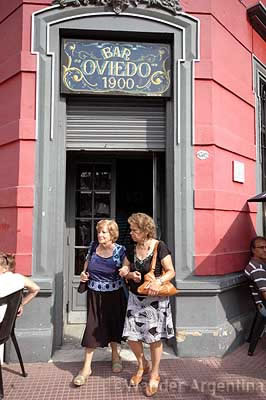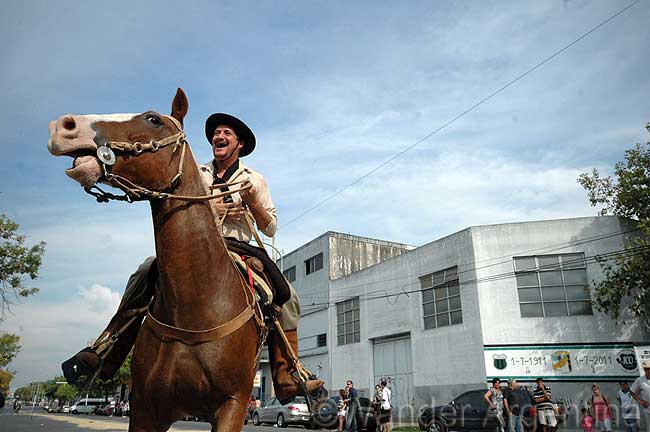Mataderos Fair is just outside the capital, only a few blocks away from where the city ends and the province of Buenos Aires begins.

Here, rural culture comes to the city: Argentine cowboys known as gauchos show off their wares, dancers and musicians cavort to Argentine folk tunes, and food stands offer various regional dishes.
In Spanish, mataderos means slaughterhouses.
Since 1889, the Mataderos neighborhood served as the region’s home to the largest livestock market and meat processing plants.
Here 50,000 head of cattle were sold weekly until 2021 when the livestock market was relocated approximately 60 kilometers (40 miles) away to Cañuelas.
The End of Horsing Around: No More Equestrian Games in Mataderos
Gauchos also performed horseback riding demonstrations and games in full cowboy garb at the edge of the market along Lisandro del Torre Avenue.
The corrida de sortija, or ring race was a main attraction at the weekly fair.
Watching giant horses gallop through parked cars did create a startling juxtaposition and was a testament to traditional and modern Argentina’s attempts to co-exist.
But the move of the slaughterhouses means that horse games were discontinued (video link).
La Feria de Mataderos Continues
Modernization may mean there are no more horse games in Mataderos, but the beloved Mataderos Fair will go on.
Just as Buenos Aires had to relocate the central fruit and vegetable market from the center of the city (it’s now Abasto Mall) and get rid of the dangerous wooden carriages of the Subte Line B, the move of the slaughterhouses out of Mataderos was the result of public pressure and strong animal rights legislation that also resulted in the conversion of the Buenos Aires Zoo into an EcoPark.
As the neighborhood transitions into a quieter residential area, Mataderos’ Sunday outdoor handicraft, culture and folklore fair will remain the area’s biggest — and only — tourist attraction.
➡ San Antonio de Areco is an excellent alternative to get the full gaucho experience and see horse games.
Food at the Fería de Mataderos
Mataderos Fair offers cuisine ranging from classics such as chorípan and empanadas; locro, a pampa stew of maize, beans and potatoes popular in winter and on national holidays.
There are also savory tamales, with meat or cheese in a corn-based flour wrapped in a corn husk, and Paraguayan specialties such Sopa Paraguaya, a savory cornbread with cheese.
In addition to lunch options, the market offers an impressive selection of high-quality homemade foods to take home including cheeses, olives oils and vinegars, charcuterie, breads, wines, liqueurs, and candies, at lower prices than can be found in Buenos Aires’ central markets.
Traditional Crafts and Souvenirs
Traditional crafts on offer in Mataderos include steak knives, wine holders, silver jewelry and handcrafted toys.
There are also quirky souvenirs available, such as boxes made out of orange peels, origami, 3D paintings and even Pope Francis memorabilia.
Live Music at the Feria De Mataderos
After shopping, grab a seat — or a dance partner — and enjoy the live Argentine folklore bands that perform from the early afternoons onward in front of the old indoor market.

Argentine folklore, including Cumbia, Zamba and Chacarera, are uplifting rural alternatives to the more famous tango.
Every week a different band is invited to play, and crowds gather to listen, dance, and watch.
Chacarera is the favorite here and local schools also often show off their moves in traditional costumes.

Other Attractions in Mataderos
The Herdsman statue (El Resero) marks the entrance to the old market.
The statue of a gaucho cattle herder and his companion, a typical Creole horse by Emilio Jacinto Sarniguet was commissioned by the city and placed here in 1932.
From 1962 to 1968 Argentine currency had a coin depicting the statue, highlighting the importance of agriculture in Argentina and the craziness of its monetary history.
 Museo de Criollo de los Corrales
Museo de Criollo de los Corrales
Hidden in a nook between the food stalls lies the Museo Criollo de los Corrales is a small museum that shows a slice of country life and the history of the gaucho life in the province of Buenos Aires.
Low-cost and worth the detour for those already in the area, the museum includes examples of traditional outfits and gaucho artifacts such as matés and horseback riding equipment.
La Pulperia inside the museum offers drinks, food, and a shaded patio away from the bustle of the fair where visitors will often find live folkloric music and dancing.
Bar Oviedo: A Mataderos Institution
The Bar Oviedo sits on the corner of Avenida Lissandro del Torre and Avenida de los Corrales, has been an institution in central Mataderos since 1900.
The restaurant serves beer, wine, the best locro in town and offers a great place to people-watch and take in the entire scene the market offers.
You’ll see gauchos, folklore dancers, the crowds of mostly Argentine tourists and families and the sellers at their booths, waiting patiently for customers to ask about their products.
The Mataderos Skate Park
Skaters and those who enjoy their gravity-defying moves won’t want to miss the Mataderos skate park at Lisandro de la Torre and Av. De Los Corrales.
It’s got a street skating area with two bowls and there’s lots of action around the park with dance parties and local women selling homemade cakes and pies.
The skatepark is open every day from 9 a.m. until 7 p.m.
Folklore Peñas (Dance Parties)
If you snoop around Mataderos you will come across other peñas – or folk music parties, aside from the one in the main plaza.
There is often an open-air peña right outside the skate park.
If it’s raining, check out the Federación Gaucho Porteña (Buenos Aires Cowboy Federation) at Lisandro de la Torre 2406.
When the Mataderos Fair Takes Place
The Mataderos Fair is every Sunday from 11 a.m. to 8 p.m., mid-March through mid-December.
In the summer months of January and February, the feria runs on Saturday nights from 6 p.m. instead of during the day.
How to get to Mataderos from Downtown Buenos Aires
Mataderos is located on Avenida Lisandro de la Torre and Avenida de los Corrales.
To get there, take the 36, 55, 92, 63, 80, 92, 97, 103, 117, 126, 141, 155, 180 or 185 bus lines.
The trip takes over an hour by bus.
To save time you can also take an Uber, taxi or take Subte line E to Plaza de Virreyes and take a taxi or Uber from there.
Alternatively, make a day of it and discover the secret gems of Mataderos Fair by taking a private guided Mataderos tour with transportation.
— by Sam Harrison (photos: Ande Wanderer)




